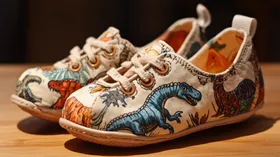Which Shoe Fabrics Are Best for Children’s Feet?
Ditch the confusion about kids' shoe materials and discover what really works for your child's growing feet.
Updated December 6, 2024.

Choosing the right kids' shoe materials can make or break your child's daily comfort and foot development. From breathable canvas to durable leather, each fabric choice shapes how confidently your little one moves through their day of active play and exploration.
Let's discover how different shoe materials work together to create the perfect foundation for growing feet.
» Explore our selection of kids' shoes with the best fabrics for growing feet
Why Shoe Material Matters
Kids are naturally sensitive to how their shoes feel, and as parents, we want them to be comfortable.
The right shoe material can significantly impact your child's daily comfort. Every child responds differently to shoe fabrics and textures—what’s perfect for one might be uncomfortable for another. This is especially true for children with sensory sensitivities.
Pay attention to how your little one reacts to different shoes. They might need a gentler, skin-friendly pair if they often try to take them off or seem uncomfortable.
» Check out our top picks for comfy kids' shoes
Why Natural Materials Are Best for Kids' Shoes
Let's take a look at natural fabrics that work well for kids' shoes.
Sheepskin: Comfortable and Practical
Sheepskin, with its natural wool fibres still attached to the hide, helps regulate temperature, making it during changing seasons. It's generally hypoallergenic, ensuring gentle comfort for sensitive skin. It also effectively manages moisture while remaining lightweight.
» Check out these sheepskin shoes that keep little toes warm
Cotton: Soft and Simple
Cotton shoes offer natural softness and breathability, making them ideal for warm weather. Because cotton is easy to clean and gentle on the feet, it helps prevent friction and irritation during playtime.
Note: Remember to look closely at the labels when shopping for cotton shoes. Even shoes marked as 95% organic cotton might contain some synthetic materials.
» Make summertime fun with our breathable sandals for kids
Denim: Strong but Flexible
Denim is very durable and keeps its shape well. But, as growing feet need space to move, it's best to save denim shoes for occasional wear rather than everyday use. They can be a good option for extra sturdiness, like at the playground or outdoor hiking adventures.
» Check out the most durable shoes for active kids
Leather: The Premium Choice
Leather shoes are a time-tested choice for children's footwear, offering exceptional quality and performance. Here's why they're worth the investment:
- Durability: High-quality leather withstands daily wear and tear, resisting scuffs and scratches that damage synthetic materials.
- Impact Resistance: Quality leather offers excellent shock absorption, protecting feet during high-impact activities. The material's natural density helps cushion each step while maintaining structural integrity.
- Breathability: Leather's porous structure allows air circulation, wicking away moisture to keep feet cool and dry. This natural ventilation helps prevent odour and maintains optimal foot health during active play.
- Custom Comfort: Over time, leather moulds to your child's unique foot shape, creating a personalised fit that enhances comfort and support. This adaptability ensures even pressure distribution and reduces the risk of blisters.
- Temperature Regulation: Leather's natural properties help maintain consistent foot temperature across seasons. It provides warmth in cooler weather while staying breathable during warmer months.
Real vs. Fake: Synthetic leather often contains chemicals that might irritate sensitive skin. Natural leather has fewer artificial components but costs more. If your child has skin conditions like eczema, this difference matters.
» See what podiatrists recommend for growing feet
Shoe Materials to Avoid
While synthetic options might seem budget-friendly, they lose their shape quickly and need frequent replacing—which can cost more in the long run. Here's what to give a skip:
- Type 3 and 7 plastics crack easily and don't let feet breathe
- Acrylic fibres and synthetic rubber fall apart quickly
- Cheap fake leather peels and makes feet sweaty
- Nylon and polyester trap heat and moisture
» Give your child the freedom to explore with our closed-toe sandals
Choose Shoe Materials That Last
As parents, we watch our little ones grow at an astounding pace. Though it's tempting to save money on shoes they'll quickly outgrow, investing in quality materials actually helps protect both your child's feet and your wallet over time.
The materials you choose for your child's shoes do more than just protect their feet—they help shape the foundation of healthy movement and physical confidence. By selecting premium materials, you're investing in every step of their journey.
Remember that each child's feet develop uniquely. When in doubt, consult a podiatrist for personalised recommendations based on your child's specific needs.
» Choose kids' shoes made from materials that ensure little feet thrive
Disclaimer: First Walkers' information is intended for educational and informational purposes related to toddler footwear and feet. We encourage you to consider individual circumstances and consult qualified orthopaedists about specific conditions.






